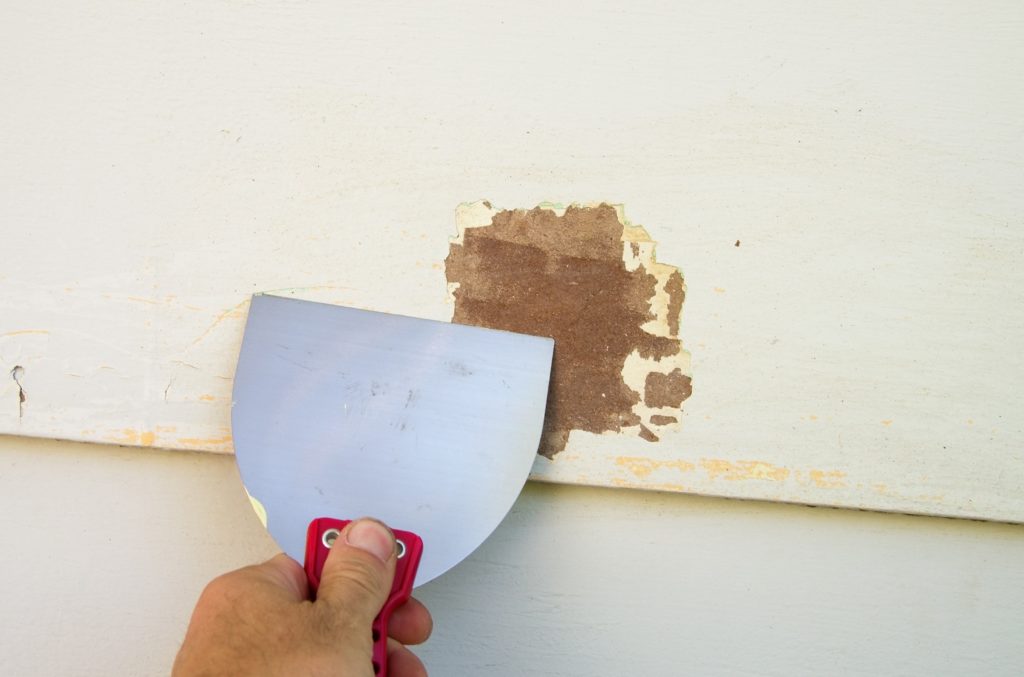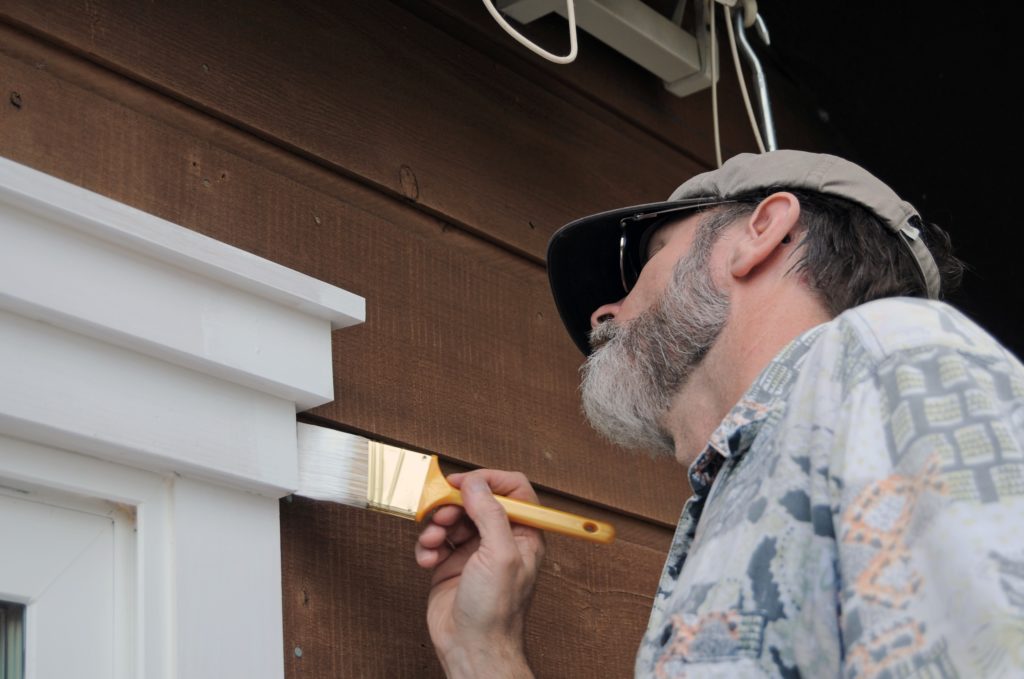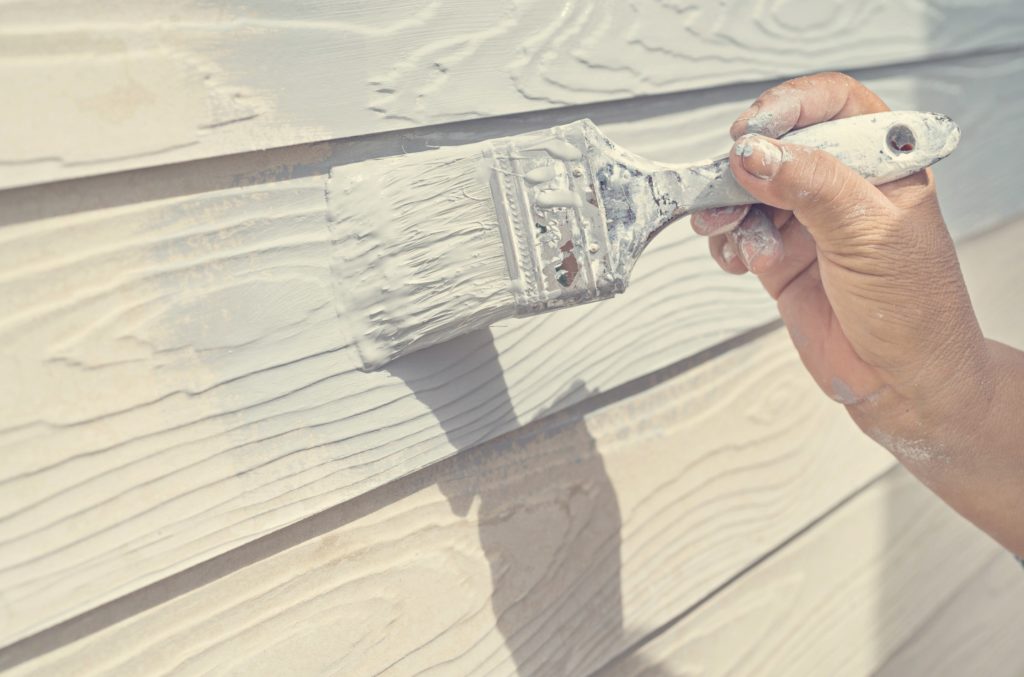How To Paint Over Old Exterior Paint Correctly?
Are you getting ready, painting over old exterior paint? Several points how to correctly paint over aged painted clapboard wood siding, will have lasting quality & protection. Painting over faded, peeling outside paint, special attention must be given.
Understanding how many coats of paint on exterior wood will seal & protect much longer. Are you repainting exterior wood trim? I bet so. Exterior wood trim is the first thing needed, when painting most exteriors.
Whether you are painting wood siding, Masonite™, T-111, clapboard siding, or wood trim, all information below, pertains to them all.
Soon, many will be painting over old exterior paint at some point, even more who wishes it to last indefinitely. Correctly repainting over existing exterior paint, will have a direct impact, as to how long your new outside paint will last. Reveling inside scoop, or techniques highly recommended.
Writing this article for both the painter, also a homeowner who wishes to know best painting practices. Giving exterior wood your very best preparations will add many years of paint quality, and protection.
Taking this from an expert in the field, giving you first-hand knowledge how an exterior paint reacts, painting over outside wood trim, and siding.
Prepare Painting Over Old Paint On Wood To Last
Before picking up a paint brush, or roller, few important steps to take in preparation, when painting over aged paint on wood to last the longest.
- Pressure washing, cleaning dirt & debris from old paint
- Checking for low moisture content (MC) percentage
- All peeling paint must be removed before any paints applied
- Checking windows, doors, trim, siding, soffits, & fascias
- Cutting, digging out rotten wood before painting over old paint
- Filling gouges with wood fillers on older surfaces
- Sanding wood fillers before priming older paint coatings
- A very good high bonding primer on all bare wood surfaces
- 2 complete coats of paint needed on wood to last
When painting over top older paint on wood for painting to last, wood substrate must be solid, sound, and sturdy. Previous coating must be bonding, adhering properly.
Wood having a moisture content no more than 13%MC. Similar preparations as to metal, fiberglass manufactured sidings, and the like.
Same preparations, exterior paint reacts positively or negatively depending on paint itself, also the surface it is covering.
Pressure washing & Moisture Content
Most concerning for outside wood is moisture content. If unsure, moisture meters are very easily obtained at local hardware stores, relatively inexpensive. Worth checking moisture content if unsure, because if MC too high, paint will dry, lifting up in a matter of weeks.
With picture above, you can see exterior siding pressure washed off currently drying out. Some wood areas drier than others, but older paint still present keeps wood wet much longer. Not trying to peel paint by high pressure water, only to rinse off siding surfaces. Leaving those areas by hand scraping later.
Those areas in direct sun will dry out much quicker, than those in shade. Ideally, using a hand scraper, going over loose edges when painting over outside wood trim.
Not getting in a hurry to start painting, allowing wood to properly dry out is your first defense.
Removing rest of old paint not properly bonding. Using a moisture meter, checking several different spots, you'll be sure siding has properly dried back out, before proceeding.
Now The Fun Part, Paint Scraping
Speaking of lifting up, if any old paint currently lifting up must be removed. All peeling paint must be scraped, before any new paint is applied. Same reason above, new paint layer will not adhere, lifting up as well.
Scraping out any deteriorated, rotten wood, getting down to a solid substrate is your number one priority. This must be done, before you go any further, applying any paint products. Don't worry about gouging wood, when removing defective old paint and rotted wood.
Once this area has dried back out, is when your repair techniques can shine. Applying fillers, exterior wood Spackle is used. Troweling it on as even as you can, letting it dry. Exterior fillers dry fairly quickly, allowing to gently sand to a smooth texture.
A good way checking wood for it's weakened structure is taking a sharp pocket knife point, sticking into the wood's surface. If knife edge can easily sink into the wood, you need to dig this portion out first.
Additional Areas To Look At
Areas where this is common to find wood decay is bottom of wood windows, doors, and where wood portions see a lot of water. Fascia and soffits are other good places to check.
Any places near water, like gutters, and roof edge, is critical having proper drainage. Certainly not dripping on wood siding walls, or any painted surfaces.

Any other moisture that may get on your clapboard siding, like a driving rain, it's a must having proper paint sheen. Correct paint sheen will allow moisture to bead up, rolling off, like water on a duck's back.
Exterior Paint Fillers
Filling any crevices, or places you've dug out with an exterior wood filler or Spackle will make like new once again. Once dried, sanding these fillers will give a smooth finish for primer to be applied.
Well, you might be saying, "I plan using a paint & primer combined in one paint". These exterior paints are generally best, some being life-time. But using high bonding primer designed for exterior use is best on troubled, and patched areas. Then using best exterior paints is even a further guarantee, for proper paint protection.
I know I'm getting off topic, repainting over old exterior paint, talking about scraping, digging out decayed areas, but any inferior surfaces needs to be addressed prior to any new paint being applied. That's is as simple as it gets. For any paint to last, previous paint currently peeling up, needs to be fully scraped away, applying any fillers, priming, before finish coats are applied.
Sanding Fillers
Very important to sand wood fillers after completely dried. Even if fillers look smooth, they really are not. Lightly sanding not only smooths, but actually fills pores. Priming & painting over wood fillers and Spackle, patches will disappear.
Using a basic hand block sander sponge usually works best. If larger areas, you may want to use an orbital sander.
Exterior Primers
I can't stress enough, using exterior primers where needed. Exterior paints are designed to bond to paint, than bare wood. Sure you can paint bare wood with a high quality exterior paint, but if you want it to last, prime it first.
Places to use a high bonding exterior primer is any places you just filled. Any places you scraped off to bare wood. Those troubled spots, say where oils are seeping through siding, a good coat of exterior primer over old paint is recommended.
Top Exterior Primers For You
Sherwin-Williams™ Extreme Bond Primer
For surfaces that require a greater degree of adhesion than our standard primers can offer, Extreme Bond Interior/Exterior Primer is up to the challenge. Designed for coating hard, glossy surfaces like tile, glass panels and plastic piping with minimal surface preparation. Can be tinted and is compatible with a full range of finish coat products.
KILZ® GENERAL PURPOSE EXTERIOR is a fast-drying latex primer and sealer, specifically formulated for outdoor use. It minimizes problems caused by surface texture and porosity differences. It’s ready to brush, roll or spray and can be topcoated after one hour with latex or oil-based paint.
Gripper Interior/Exterior Primer & Sealer is a premium acrylic primer and sealer designed to meet the variety of challenges experienced in the residential, commercial and multi-family markets for a multi-purpose primer. This fast-drying, all-purpose, bonding primer and sealer is suitable for interior or exterior application with its excellent adhesion to a variety of surfaces. Ideal for use on properly prepared interior or exterior wood, masonry, plaster, wallboard, cement, brick and stucco.
Choose from a range of professional-quality interior and exterior acrylic latex primers that are quick-drying, feature excellent adhesion and have great hiding and sealing qualities.
Valspar Exterior Multi-purpose Water-based Primer
- Seals, primes and protects outdoor surfaces
- Blocks stains and resists mildew
- Prepares bare wood for superior top coat adhesion
- Ideal for fiber cement siding, concrete, masonry, wood, aluminum and vinyl
- Weather resistant
- Fast drying
- Seals porous surfaces for fewer top coats
- Mildew-resistant finish
How Many Coats Of Paint On Exterior Wood Needed?

Wondering how many coats of paint do you need on wooden surfaces is a very good, common question. With today's revolutionary technology, paints have been improved 180 degrees over last ten years.
Today, some paint selections only require one thick even coat. Costing much more, but using less quantity, the quality of each is far superior. Most exterior life-time paints, only requiring one coat, are more fade resistant.
But giving your exterior an arsenal of weatherproofing bonding sealer, prime bare exterior wood siding first. This combination insures proper adhesion, sealing, also weatherproofing. Not allowing moisture penetrating wood trim or siding, to cause peeling, cracking, or blistering.
Why fade resistant is important, is fade is the first thing to be seen as paint ages. If your exterior paint resists paint fade the longest, it will retain it's original structure and chemical makeup longer, thereby not cracking, peeling, or chipping up.
Exterior paints which are not of the highest paint quality, normally require two complete coats, wet on dry, paint application method. This means, allowing first coat to dry, before applying second coat. Either exterior lifetime paint or not, you really need to have 10-13 mils of dry paint as an end result for all painted wooden areas.
Couple Common Questions In The Painting Sector
Oil Vs. Latex
"Can I Paint Over Oil Paint With Latex Paint"?
or–
"Can I Paint Over Latex Paint With Oil Paint"?
Right to the point, you can paint over oil or Alkyd paint using latex or water-borne paint. Reason why is Acrylic latex emulsion paint drys much quicker, not near as caustic, having many more petroleum products included.
Just as important as this is, equally important you should not paint over latex using oil.
Painting an oil-based paint over a latex, look out! If it properly dries, consider yourself lucky.
These two questions are extremely important painting over exterior concrete epoxy paint, and wood floors, or wooden decks. If you have a garage, wood floor, or kitchen wood cabinets previously painted.
Wanting to repaint it, you really need to know what is currently on the surface. If not, your new paint could lift up in no time.
How To Repaint Exterior Wood Trim
Wanting to repaint exterior wood trim correctly? If painting entire home, repainting exterior trim is typically last to paint. Reason why is it's much easier to tape & mask on a larger surface, caulking tape edge before painting trim.
Correctly repainting exterior wood trim is one of the most important areas painting, because more eyes are directed to these areas. Making sure trim boards having no signs of moisture, and all peeling paint has been removed. Critical steps to take, painting over old exterior paint, making them look brand new, not seeing previous paint coats applied years before.

Scraping any deteriorated old paint and rotten wood, acting like a sponge, down to solid wood portions is ideal. Filling any holes, gouges where dilapidated wood was removed is a must. Priming all bare wood surfaces before painting final paint coatings is another must.
Having clean, smooth lines, proper paint thickness (8-13mils). Using proper brush & rollers designed for surfaces you are painting will make finished trim look that much better. Another words, no need to use a 4" brush on a 2" wide trim board.
Same goes for not using a 2" brush on a 12" wide piece of trim. Reasons for this is you want to limit as many brush lines as possible. Having the smoothest, uniform, continuous coating as possible, looks most professional.

Using proper paint finish sheen is another important factor painting outside trim correctly. For a lasting paint coating, being most weather resistant, painting trim with a glossy, slick to touch finish. Satin finish repels moisture ideally. Not only satin water-proofs trim, but you can use same sheen on entire exterior, being most appealing.
Best Trim Paint Near You
Conclusion
How to paint over previously painted exterior paint correctly, several steps needed, insuring not only proper adhesion, but having a lasting, professional paint coating. Taking extra time now, will save you much time, money, and efforts down the road.
Making sure you've waited enough time after pressure washing, cleaning moisture content is the lowest, then scraping, filling, priming. Using proper exterior paint sheen, along with brush & roller size for your trim surfaces, will ultimately look the best.
If you need help painting over old exterior paint correctly in Denver, CO., look no further for a professional team of painters with Eco Paint, Inc. painting your entire exterior home or business correctly.
Being outside the Denver area, hope this information helps you repainting your next exterior wood properly. Like to hear from you with any comments below, and/or like, share, & follow!













Thank you Cal! I am painting an old bungalow in upstate New York, and your article helped a lot.
[…] Best primers will have extreme bonding characteristics. Higher adhesion properties is exactly what you want for several reasons. […]
It depends on how you will apply the paint. Even though this is old we are not sure how beautiful it is outside and inside.